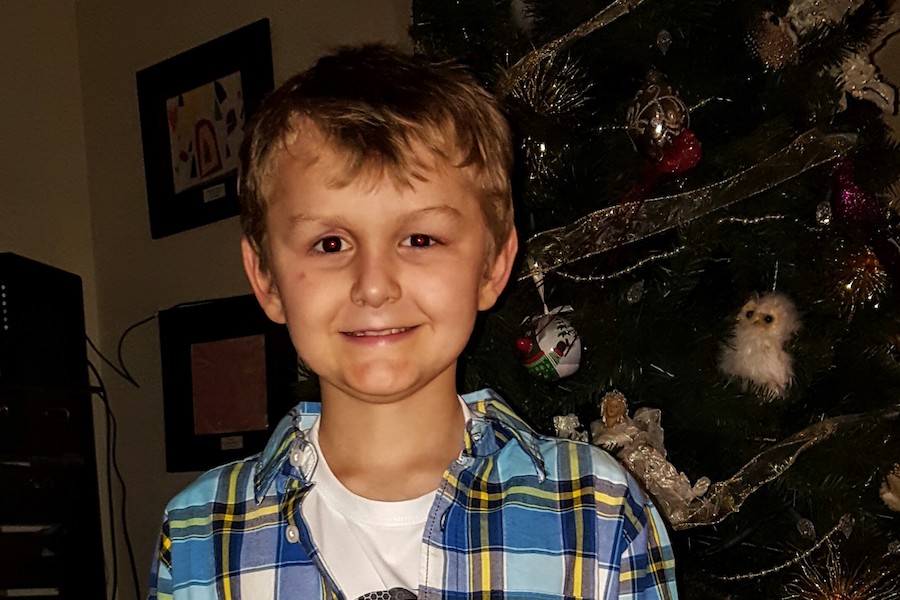Every parent knows the routine. The dreaded “head check” letter arrives from your child’s school and you expect to find nothing. This was this situation for Blaze’s grandma, Lisa. She didn’t expect this result.
“I was just doing head checks and found lumps by Blaze’s ears. It kind of freaked me out a little bit. So I started checking other areas with lymph nodes, and they were all enflamed too. He had all these little purple petechea all over his belly. So I made all my other kids get dressed (it was bedtime) and we went up to the local hospital and they did some blood work. And the doctor probably instantly knew. I know I had a bad feeling,” Lisa recalled.
Three short days after Lisa performed that routine head check, Blaze began treatments for Acute Lymphoblastic Leukemia (ALL). His aggressive treatment included eight radiation treatments to his head, 3 ½ years of chemotherapy and multiple surgeries. Blaze was declared in remission, but it was short-lived.
During the next few years, Blaze would be considered in remission several times, only to have the cancer come back in his eyes, testicles, sinuses, and other soft tissue. He received a bone marrow transplant, thanks to his older sister, who was a 100% match.
Blaze and his sister, Harmoni
Before his transplant, Lisa’s social worker contacted Compass to Care for assistance. There were many long trips in preparation for the transplant, and Lisa just needed some help getting back and forth.
For Lisa, not knowing when or how Blaze might relapse, has made it difficult to get and keep a steady job. She had to close her in-home daycare when he got sick, partly because of Blaze’s compromised immune system and partly because she just never knew when she might have to drop everything and take him to the hospital.
“I have always been the type of person who plans, but now I can’t do that. When he gets sick, I’m going to go be with him,” Lisa states. This is the kind of support she tries to show her kids. For example, Blaze and his 2 siblings came to live with Lisa when their mother, her daughter, decided she could no longer care for them. Lisa and her son took them right in, more than doubling the size of their small household.
Recently, Blaze was accepted into a CD19 CAR T-cell study, over 500 miles away in Philadelphia. The first treatment had them away from home for 7 ½ weeks. For two years, they need to return every three months, so Blaze can get a biopsy to make sure his b-cells are not growing back.
“They take a lot-it’s a big biopsy. It wipes him out so much they make him stay overnight. Then, if there’s no bleeding and everything else is ok, we get to go home,” Lisa explains. If his cancer remains in remission throughout the first two years, he will only have to go once every 6 months.
But these 4-5 day trips are hard on the family. Lisa’s niece comes from out of state to stay with her other kids while she and Blaze are in Philadelphia, so at least there is family around. Lisa gets emotional when thinking about all those who have helped them.
“A lot of people don’t understand what it is to be in our shoes. Without Compass to Care it would be so hard to get to our appointments. Everyone saves our kids, volunteers, donors – not just doctors. I don’t know how I would’ve gotten Blaze back and forth without everyone’s help. Thank you!”
What is the CD19 CAR T-cell study? It’s a form of immunotherapy known as chimeric antigen receptor (CAR) T-cell therapy. Doctors harvest the patient’s T-cells in order to modify them to recognize and kill cancer cells.
First, the doctors hooked Blaze up to a big machine that pumped all of his blood out of his system and replaced it with other blood, so they could harvest his T-cells in order to modify them to create what are called monster cells.
When the monster cells were ready (in about 2 weeks), Blaze received 3 doses of chemo, to kill all of his B-cells. Meaning he now has absolutely no immune system. As long as the B-cells don’t return during the study, the treatment is working. If they do, they will kill the monster cells and foil the treatment.
Next, they injected him with the monster cells. These cells find the leukemia cells and attack them, causing swelling. Lisa said that a lot of kids don’t make it past this point without a severe reaction.
“They call it ‘The Storm’. The patient gets a high fever. They have to be put on respiratory machines for a couple days, or weeks. Then ‘boom’ all of a sudden, it’s over and they are in remission. They say only 10% of kids put through this will not experience The Storm. Luckily, Blaze was in the 10%. No fever, no storm,” Lisa shares. The monster cells have been working for almost 9 months. Soon, Lisa and Blaze will find out if he is in remission again.


